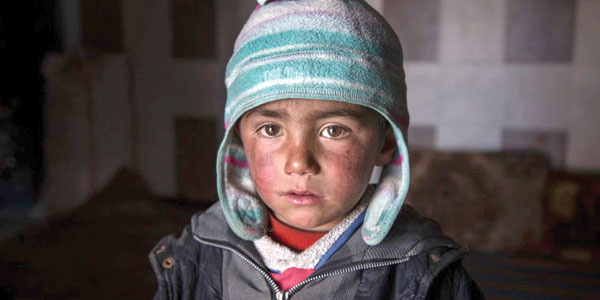
Todo comenzó con los niños.
Las imágenes son espantosas. Una muestra a por lo menos seis niños muertos, con los ojos abiertos, luego de un ataque con armas químicas en el norte de Siria. En otra, un padre está cargando en ambos brazos los cuerpos de sus gemelos recién fallecidos. Y en varias más hay menores de edad, apenas moviéndose, aferrándose a la vida con cada respiro.
Esas son las imágenes que acabaron por convencer al presidente Donald Trump de que tenía que atacar al régimen en Siria del dictador Bashar al-Assad. “Incluso hermosos bebés fueron asesinados cruelmente en este ataque barbárico”, declaró Trump horas antes de ordenar el bombardeo contra Siria. “Ningún niño hijo de Dios debe sufrir ese tipo de horror”.
A Trump siempre le pareció una señal de debilidad que el expresidente, Barack Obama, no hubiera cumplido su amenaza de atacar a la dictadura de Siria si usaba armas químicas. De hecho, Assad cruzó esa “línea roja” en agosto del 2013 cuando unas 1,400 personas murieron por gas sarín a las afueras de Damasco, la capital. Un reporte indica que murieron 426 niños en ese ataque.
Trump hizo lo que Obama no quiso hacer, y ahora está metido en uno de los conflictos más complicados del mundo. Siria es un país hundido en los últimos seis años en una terrible guerra civil, con un brutal dictador hijo de otro brutal dictador. Rusia e Irán apoyan al gobierno sirio en su lucha contra un desorganizado pero insistente grupo de rebeldes.
Además, hay una fuerte presencia del grupo terrorista ISIS en el territorio. Todo esto ha generado las muertes de más de 250 mil personas. Al menos 5 millones de sirios han huido como refugiados a naciones vecinas, según la ONU.
En ese polvorín se ha metido Trump. Si quiere seguir la llamada Doctrina Powell, tiene que explicarnos cómo Siria amenaza la seguridad nacional de Estados Unidos y cómo piensa salirse de ahí luego de los bombardeos.
Estados Unidos actualmente ya está involucrado en dos guerras, en Irak y en Afganistán. Obama, como vimos, evitó durante ocho años el meterse en otro conflicto militar a pesar del desafío que le planteó el gobernante sirio y de las recomendaciones de algunos de sus asesores. Pero Trump, en el tercer mes de su presidencia, ya está metido en el lugar más complejo del planeta.
Ya dio el primer paso, y ahora no hay decisiones fáciles. Insistir en la salida del dictador sirio implicaría, si cae, un enorme vacío de poder. ¿Está dispuesto Estados Unidos a cambiar de régimen en Siria y encargarse de crear un nuevo gobierno de transición?
Además, la prioridad de Trump durante su campaña el año pasado nunca fue terminar con la dictadura siria; fue destruir al grupo ISIS y evitar nuevos ataques terroristas en Estados Unidos y contra estadounidenses en el extranjero. Una nueva guerra en Siria cambiaría radicalmente la agenda de su gobierno y obligaría a gastar billones de dólares que tanto se necesitan en escuelas, infraestructura y seguros médicos.
Es loable, sin duda, la defensa de los niños sirios. Pero la gran ironía es que esos mismos niños y sus familiares que fueron atacados por el régimen de Assad no podrían entrar como refugiados a Estados Unidos si se pusiera en práctica la prohibición de vuelos propuesta por Trump. Esa prohibición en contra de los ciudadanos de seis países, incluyendo Siria, está atorada en las Cortes.
Para los opositores de Trump, lo que está ocurriendo es un escenario de pesadilla. Claramente no confían en la personalidad irascible y cambiante del Presidente. Pero, en momentos de un conflicto bélico como éste, es difícil para ellos criticar públicamente al comandante en jefe.
Aquí la credibilidad del Presidente es vital. ¿Cómo confiar ahora en Trump cuando en el pasado ha mentido abiertamente sobre el lugar de nacimiento de Obama, sobre la votación de tres millones de indocumentados y sobre el supuesto espionaje ordenado contra la Torre Trump, entre muchas otras falsedades?
No se le puede creer a Trump en esos temas. ¿Se le puede creer sobre Siria? Es, al final, una cuestión de confianza. ¿Le crees al Presidente lo suficiente como para apoyarlo en caso que decida comenzar una nueva guerra?
Todo esto es nuevo para Trump — y para nosotros.
(Jorge Ramos, periodista ganador del Emmy, es el principal director de noticias de Univisión Network. Ramos, nacido en México, es autor de nueve libros de grandes ventas, el más reciente de los cuales es “A Country for All: An Immigrant Manifesto”.)
(¿Tiene algún comentario o pregunta para Jorge Ramos? Envíe un correo electrónico a Jorge.Ramos@nytimes.com. Por favor incluya su nombre, ciudad y país.)
The Children Caught in Syria’s War
The images were heartbreaking. One showed at least six children dead, their eyes still open, after a chemical weapons attack killed more than 100 people earlier this month in northern Syria’s Idlib Province. In another image, a distraught father carried the bodies of his dead twins. Many more showed children barely moving, clinging to life with each breath.
Images like these, broadcast around the world shortly after the attack, pushed President Trump to intervene against the Syrian dictator Bashar Assad, whom the United States blamed for the tragedy.
“Even beautiful babies were cruelly murdered in this very barbaric attack,” Trump said right after retaliating with a missile strike on a Syrian airfield. “No child of God should ever suffer such horror.”
Trump also blamed President Obama for failing to stand up to Assad after the dictator crossed Obama’s notorious “red line” on using chemical weapons. In August 2013 Assad launched a sarin gas attack that killed about 1,400 civilians, including more than 400 children, on the outskirts of Syria’s capital, Damascus. (At the time Trump himself took to Twitter to urge Obama not to get involved.)
Now Trump has done what Obama would not by entering one of the most complicated conflicts in the world. For the last six years, Syria has been blasted to rubble by a civil war under the leadership of a brutal dictator (who is the son of the previous brutal dictator). Russia and Iran support Assad’s battle against a disorganized but relentless group of rebels, while the Islamic State has established a strong foothold in the region.
More than 250,000 people have been killed during the conflict, and at least 5 million Syrians have fled to neighboring countries, according to the United Nations. Now Trump has stepped into that minefield.
If he wants to follow the Powell Doctrine — the standard that Gen. Colin L. Powell set when he was chairman of the Joint Chiefs of Staff under President George H.W. Bush — Trump now must explain to the American people how Syria is a threat to U.S. national security and what his exit strategy is.
The United States is already involved in wars in Iraq and Afghanistan. Obama avoided entering another major military conflict for eight years, despite recommendations from some of his advisers that he should act against Syria. But Trump, three months into his presidency, is already entangled there.
He quickly took the first step, but there are no easy decisions ahead. Overthrowing Assad would create a huge power vacuum. Is America willing to replace the Syrian regime and oversee the creation of an interim administration?
During Trump’s presidential campaign, he said that his priority was to destroy the Islamic State and prevent terrorist attacks in America and against Americans abroad, not to end the Syrian dictatorship. A new war would fundamentally change his administration’s agenda and would cost billions of dollars badly needed here at home for schools, infrastructure and health care.
The defense of Syrian children is praiseworthy. But the colossal irony is that those same children and their families wouldn’t be allowed to enter the United States as refugees if the immigration ban proposed by Trump were to be implemented. The ban, now stuck in court, applied to six Muslim-majority nations, including Syria.
Trump’s attack on Syria might inhibit some of his opponents from openly criticizing their dishonest, irascible commander-in-chief. But moments such as these are when the president’s credibility is essential. How can people have faith in Trump after his blatant lies about Obama’s place of birth, about the votes of 3 million undocumented immigrants and about the alleged wiretapping of Trump Tower, among many other falsehoods? If Trump can’t be trusted on these issues, can he be trusted on Syria?
This all comes down to credibility. People have to be able to believe Trump if he decides to make the case to start another war — and trusting him on such an important decision will be a new and difficult test.
(Jorge Ramos, an Emmy Award-winning journalist, is a news anchor on Univision and the host of “America With Jorge Ramos” on Fusion. Originally from Mexico and now based in Florida, Ramos is the author of several best-selling books. His latest is “Take a Stand: Lessons From Rebels.” Email him at jorge.ramos@nytimes.com.)










